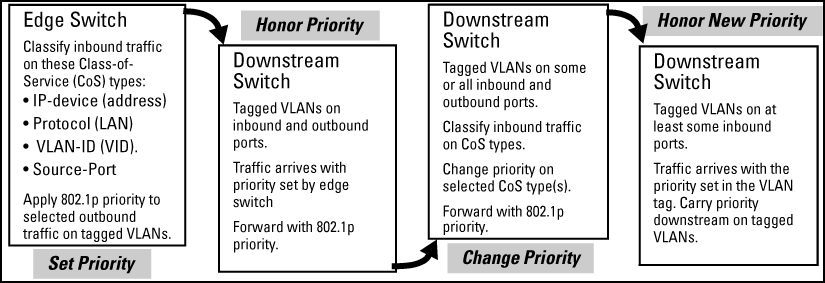A Quality of Service (QoS) network policy refers to the network-wide controls available to:
-
Ensure uniform and efficient traffic-handling throughout your network, while keeping the most important traffic moving at an acceptable speed, regardless of current bandwidth usage.
-
Exercise control over the priority settings of inbound traffic arriving in and travelling through your network.
Adding bandwidth can be a good idea, but is not always feasible and does not completely eliminate the potential for network congestion. There will always be points in the network where multiple traffic streams merge or where network links change speed and capacity. The impact and number of these congestion points will increase over time as more applications and devices are added to the network.
When network congestion occurs, it is important to move traffic on the basis of relative importance. However, without QoS prioritization, less important traffic consumes network bandwidth and slows down or halts the delivery of more important traffic. Without QoS, most traffic received by the switch is forwarded with the same priority it had upon entering the switch. In many cases, such traffic is normal priority and competes for bandwidth with all other normal-priority traffic, regardless of its relative importance to your organization's mission.
QoS is used to classify and prioritize traffic throughout a network. QoS enables you to establish an end-to-end traffic-priority policy to improve the control and throughput of important data. You can manage available bandwidth so that the most important traffic goes first. For example, you can use QoS to:
-
Upgrade or downgrade traffic from various servers.
-
Control the priority of traffic from dedicated VLANs or applications.
-
Change the priorities of traffic from various segments of your network as your business needs change.
-
Set priority policies in edge switches in your network to enable traffic-handling rules across the network.
At the edge switch, QoS classifies certain traffic types and in some cases applies a DSCP policy. At the next hop (downstream switch) QoS honors the policies established at the edge switch. Further downstream, another switch may reclassify some traffic by applying new policies, and yet other downstream switches can be configured to honor the new policies.
QoS is implemented in the form of rules or policies that are configured on the switch. Although you can use QoS to prioritize traffic only while it moves through the switch, you derive the maximum benefit by using QoS in an 802.1Q VLAN environment (with 802.1p priority tags) or in an untagged VLAN environment (with DSCP policies in which QoS sets priorities that downstream devices can support without re-classifying the traffic).
By prioritizing traffic, QoS supports traffic growth on the network while optimizing the use of existing resources—and delaying the need for further investments in equipment and services. QoS enables you to:
-
Specify which traffic has higher or lower priority, regardless of current network bandwidth or the relative priority setting of the traffic when it is received on the switch.
-
Change (upgrade or downgrade) the priority of outbound traffic.
-
Override "illegal" packet priorities set by upstream devices or applications that use 802.1Q VLAN tagging with 802.1p priority tags.
QoS on the switches covered in this guide support these types of traffic marking:
-
802.1p prioritization: Controls the outbound port queue priority for traffic leaving the switch, and (if traffic exits through a VLAN-tagged port) sends the priority setting in packet headers to downstream devices.
-
IP Type-of-Service (ToS): Enables the switch to set, change, and honor prioritization policies by using the Differentiated Services (diffserv) bits in the ToS byte of IPv4 packet headers.

